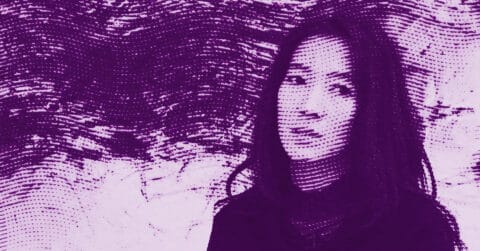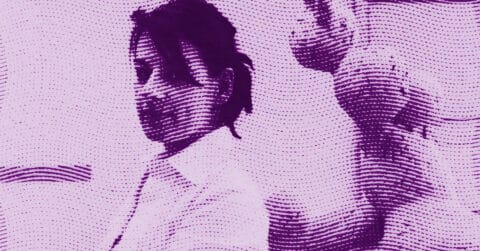Listen to me carefully, you bunch of snobs, when I talk to you about the art of Miriam Cahn (born in 1949), this Swiss artist who blasts our certainties with the power of an atomic bomb. In her bunker-studio in Grisons, far from the superficial social gatherings of the contemporary art scene, she creates each day for exactly three hours, like a Zen monk who would have traded his saffron robe for a paint-stained work smock. Not a minute more, not a second less. An immutable ritual that gives birth to works as impactful as a Mike Tyson uppercut in his prime.
First, allow me to tell you about her technique, as brutal as it is effective, which redefines the boundaries of contemporary art. Cahn paints as she breathes, in urgency and absolute necessity, with an intensity that makes the walls of her Alpine studio tremble. Her canvases are born from a body-to-body encounter with the material, without prior sketch, without possible repentance, in a fierce battle against time and conventions. An approach that is reminiscent of Martin Heidegger’s philosophy of the present moment, the concept of “Dasein” where being reveals itself in pure action, free from the trappings of reflection. But beware, do not be mistaken: behind this apparent spontaneity hides an absolute mastery of the medium, like a judoka who has spent years perfecting a single move to make it deadly.
Her human figures, those fluorescent ghosts who stare at us with eyes empty like bottomless pits, emerge from the canvas like radioactive specters, bathed in colors so intense they seem to pulse with their own life. These bodies, often nude, sometimes fragmented like the victims of an explosion, tell the violence of the world with a force that even Francis Bacon, a master in this field, might have envied. Each brushstroke is as precise as a scalpel, each line as sharp as a razor blade. These figures are not mere representations, but presences that inhabit the space with the authority of ancient sculptures, while bearing the scars of our brutal modernity.
Cahn’s technique is unique in that it combines an almost violent speed of execution with surgical precision in the choice of colors and shapes. She works urgently, certainly, but each gesture is as calculated as a game of chess where every move can be fatal. Her large formats, often created on the floor like Pollock’s action paintings, are not the result of chance but the product of a meticulously orchestrated choreography where the whole body participates in the creative act.
Violence, the central theme of her work, is never gratuitous or spectacular. It is the mirror of our time, the cruel reflection of our daily barbarities, from the wars that tear the world apart to the more intimate violences that occur in domestic spaces. From the conflicts in former Yugoslavia to the Ukrainian tragedy, Cahn captures the very essence of horror with an economy of means that commands respect. A simple charcoal line can suggest a tank, a blot of color can evoke a tortured body. This approach takes us back to Walter Benjamin’s thought on the mechanical reproduction of art in the modern era, where the image of war becomes so common that it loses its power to provoke indignation. Cahn, instead, forces us to look, to not turn away from this spectacle of destruction.
In her series devoted to contemporary conflicts, she develops a visual language that transcends simple reporting to reach a universal dimension. Her refugee figures, for example, are not mere illustrations of current events but archetypes that speak to us of exile, fear, survival. The bodies she paints carry within them the entire history of human suffering, from the forced migrations of antiquity to the contemporary tragedies of the Mediterranean.
The feminist dimension of her work is particularly interesting because it transcends mere activism to reach a deeper truth about the human condition. Her female bodies are not passive victims but telluric forces, modern Amazons who claim their sexuality with a frankness that can shock sensitive souls. The genitals, represented without disguise or modesty, become symbols of resistance, weapons of combat in an endless gender war. This radical approach to representing the female body is part of a tradition that goes from Louise Bourgeois to Marlene Dumas, while creating its own visual vocabulary.
This assumed crudity brings us back to Simone de Beauvoir’s thought on the female body as a battlefield. But where Beauvoir theorized, Cahn embodies. Her women are not philosophical concepts but carnal presences that explode the conventions of representation. They urinate, bleed, give birth, fuck with a freedom that shatters centuries of artistic prudery. Each canvas is a manifesto, a declaration of war against the established norms of female representation in art.
The very format of her works participates in this strategy of confrontation. By systematically hanging them at eye level, Cahn forces the viewer to a face-to-face with no possible escape. It is impossible to take the comfortable distance of traditional aesthetic viewing. We are caught, sucked into these gazes that fix us like so many disturbing mirrors of our own humanity. This staging recalls Jacques Lacan’s theories on the mirror stage, where self-recognition necessarily passes through confrontation with the other.
Her color palette, bold to the point of sometimes bordering on the unbearable, plays with violent contrasts that evoke the experiments of Vassily Kandinsky on spirituality in art. But whereas Kandinsky sought cosmic harmony, Cahn cultivates dissonance. Her electric blues sit alongside flesh pinks in compositions that seem to defy all conventional chromatic logic. Acid yellows engage in dialogue with deep blacks in a macabre dance that speaks to us of life and death, creation and destruction. It is precisely in this tension that the strength of her work lies.
The landscapes, when they appear in her work, are never mere backdrops but full-fledged actors in the drama played out on the canvas. Whether it is her views of the Swiss Alps or her imaginary territories, they carry the memory of human tragedies within them. A solitary tree becomes a silent witness, a mountain transforms into a funerary monument. Nature, for Cahn, offers no bucolic refuge. It is both accomplice and victim of our madness, as Friedrich Nietzsche so well understood in his conception of the terrible sublime. These landscapes remind us that human violence is not limited to interpersonal relationships but extends to our relationship with the environment.
This tragic dimension is paired with a profound reflection on memory and history. Born into a Jewish family that fled Nazi persecution, Cahn carries within her the weight of a collective history that permeates each of her works. But she does not merely bear witness. She transforms this burden into a creative force that transcends the simple duty of remembrance to reach a universal dimension. Each canvas thus becomes a place of memory, in the sense intended by Pierre Nora, a space where personal and collective history crystallizes and transforms.
Her work on contemporary migrants perfectly illustrates this ability to transform historical experience into artistic vision. Her fleeing figures, reduced to ghostly silhouettes, carry within them the distress of the world without ever descending into sentimentalism. They remind us of Hannah Arendt’s reflections on the stateless person as an emblematic figure of our modernity. These works are not simple illustrations of current events but profound meditations on the human condition in the era of large population displacements.
Performance, a major aspect of her practice, manifests itself not only in the act of creation but also in the spatial arrangement of her exhibitions. Each installation becomes a unique event, a meticulously orchestrated choreography where each work dialogues with the others in a visual score of rare intensity. This is where Maurice Merleau-Ponty’s thought on the phenomenology of perception takes on its full meaning: space is no longer a simple container but becomes an integral part of the work. The spectator is invited to actively participate in this experience, their body becoming an element of the overall composition.
In her charcoal drawings, made directly on the floor in a sort of creative trance, we find the same physical urgency. The whole body participates in the act of creation, transforming the paper’s surface into a battlefield where something greater than art is at play. These works remind us of Antonin Artaud’s experiments on the theater of cruelty, where the body becomes the vehicle of a truth that surpasses language. The trace of the gesture, the imprint of the artist’s body remain visible like scars from a battle against matter itself.
The texts that often accompany her works are not mere comments but an integral part of her artistic approach. Written in a language as direct as her painting, they bear witness to a thought that refuses compromises and easy ways out. Every word is weighed, every sentence is a blow struck against traditional artistic propriety. These texts function like scores guiding our reading of the works while preserving their fundamental mystery.
Each working session of Miriam Cahn is a new battle, a new challenge thrown at artistic conventions. This consistency in intensity, this discipline in revolt, makes her work a unique testimony to our era. Miriam Cahn’s art is a salutary slap in the overly smooth face of contemporary art. In a world where aesthetics is too often reduced to an “Instagrammable” commodity, she reminds us that art can still be dangerous, that it can still hurt us, make us think, make us grow. She is the living proof that painting, this supposedly dying art, can still roar with the strength of a wounded lion. Her work will remain an essential testimony of our time, a cry of rage and hope in the darkness of our days.
















